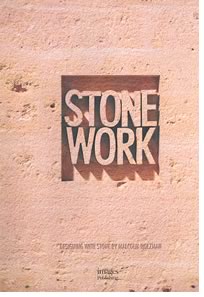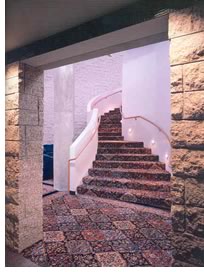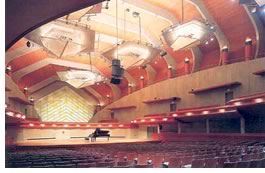
by Malcolm Holzman, FAIA (images Publishing, 2002)
reviewed by Stephanie Stubbs, Assoc. AIA
Managing Editor
 Maybe
you can't judge one by its cover, but Stone
Work gives you a pretty good hint. Its jacket offers an open field
of a rosy, rough-hewn sandstone, with the subhead and author's credit
neatly and unobtrusively "chiseled" in. The main title block
looks finely carved, and its subtly embossed letters are high gloss, like
softly polished stone. Someone, you know, designed this book very carefully.
Maybe
you can't judge one by its cover, but Stone
Work gives you a pretty good hint. Its jacket offers an open field
of a rosy, rough-hewn sandstone, with the subhead and author's credit
neatly and unobtrusively "chiseled" in. The main title block
looks finely carved, and its subtly embossed letters are high gloss, like
softly polished stone. Someone, you know, designed this book very carefully.
Now you can open it. If you're the reserved, organized type, just flip to lovely end plates, which offer an orderly quilt of different-colored stone wall applications. If you're the impetuous, carefree kind, fan the pages and get bowled over by the exquisite color photographs, many of them full-page and even full-spread, showing projects by author Malcolm Holzman's New York City firm, Hardy Holzman Pfeiffer Associates. Either way, be prepared to fall in love—this book is drop-dead gorgeous!
 Depth
of scale
Depth
of scale
But of course you wouldn't just fall for a pretty face; this book has
plenty of smarts and character, too. Through thoughtful, crafted essays,
Holzman offers a career's worth of reflection and exploration of an ancient
material and how it can be used in modern (and in the case of HHP, award-winning)
ways. Each one has a rock-related title—"Grindstone," "Milestone,"
"Keystone," and the like, and in each one Holzman shares some
of his practical experience and relates it to a particular building project.
Many say that architects learn best by case study, and such projects abound in Stone Work. They are tied directly into the essays, and then synopsized in the appendix. Buildings so detailed include:
 •
McClurg Hall, University of the South, Sewanee, Tenn., which employs sandstone
split and cut stone with an unforgettable array of nine-foot-tall finials
•
McClurg Hall, University of the South, Sewanee, Tenn., which employs sandstone
split and cut stone with an unforgettable array of nine-foot-tall finials
• West Wing, Virginia Museum of Fine Arts, Richmond, Va., which uses rusticated blocks of limestone
• Whitaker Center for Science and the Arts, Harrisburg, Pa., built of sandstone blocks
• Stokes Wing, the Cleveland Public Library, the subject of This Week's practice tips, which uses marble split-face blocks, fluted quarry block faces, and sawn dimensional stone, with granite lintels.
 Weight
of history
Weight
of history
While most of the building examples are from HHP's lifetime, which began
in 1967, Stone Work runs the gamut
from ancient application to modern use, and even direction for the future.
"The succession of construction techniques applied to stone buildings
is as diverse as the history of architecture itself," Holzman reminds
us. From the stone cutter and the mason, whose works of necessity gave
stone buildings a human scale, stone ruled as a building material until
manufactured products began their rise in the eighteenth century. Curiously,
as manufactured materials and concurrent styles evolved, they gradually
stopped prizing one of stone's most defining characteristics: depth. The
culmination was the Modern Age: "A flat surface was considered superior
to a three-dimensional one, and a flat surface with minimal detail was
deemed even better."
 Holzman
tells us that it took only three decades (from 1960 to 1990) from the
use of stone in buildings to "evolve" from the age-old method
of blocks and mortar to thin-skin panels and adhesives. The new systems
became popular because they are cheaper, yet "they bear little resemblance
to stone's origin as a building material, giving no particular insight
into its inherent properties." He offers this hope for the future:
"For the current modernism to evolve, the use of stone should move
beyond the expediency of panelization. It should embrace new technology
and economics but it should also incorporate ways to espouse the lyricism,
beauty, and human qualities that stone so eloquently expresses."
Holzman
tells us that it took only three decades (from 1960 to 1990) from the
use of stone in buildings to "evolve" from the age-old method
of blocks and mortar to thin-skin panels and adhesives. The new systems
became popular because they are cheaper, yet "they bear little resemblance
to stone's origin as a building material, giving no particular insight
into its inherent properties." He offers this hope for the future:
"For the current modernism to evolve, the use of stone should move
beyond the expediency of panelization. It should embrace new technology
and economics but it should also incorporate ways to espouse the lyricism,
beauty, and human qualities that stone so eloquently expresses."
In Stone Work's introduction, Holzman says, "To raise public awareness about the material and to influence architects to redirect their attention to stone is my objective. They will discover, as I have, that it is sensuous to the touch, striking to the eye, and pleasing to the soul." Holzman made a good start on this mission with this book, which, if we may, is sensuous to the touch, striking to the eye, and pleasing to the soul.
Copyright 2002 The American Institute of Architects. All rights reserved.
![]()
|
To read a "Best Practices" tip about visiting the quarry from Stone Work, click here. To purchase a copy of Stone Work from the AIA Bookstore ($54 AIA members/$60 nonmembers) phone 800-242-3837 option #4, fax 202-626-7519, or email. The AIA 2002 Convention and Expo, May 9 to 11 in Charlotte, features a Stone and Tile Pavilion, sponsored by Stone World and Contemporary Stone & Tile Design magazines. The pavilion shows the latest products and services in the stone and tile industry. Click for complete convention information. |
|